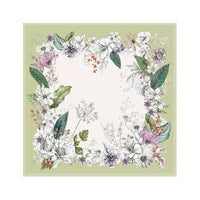Vincent van Gogh's "Roses": A Hymn to Life and Resilience
Vincent van Gogh, the Dutch post-impressionist painter, remains one of the most influential figures in the history of art. His unique artistic style and profound emotional expression left an indelible mark on the world. Among his many masterpieces, Roses, painted in 1890, stands out not just as a still life, but as a poignant reflection of van Gogh's inner world and his enduring passion for life, even as he faced immense personal struggles.

Creation in the Final Chapter of Life
Van Gogh painted Roses in 1890, during the final years of his life, a period marked by severe mental and emotional distress. After experiencing multiple breakdowns, he voluntarily admitted himself to the Saint-Paul-de-Mausole asylum in Saint-Rémy-de-Provence, France. Despite the hardships he endured, van Gogh never lost his commitment to art. The surrounding natural beauty, particularly the gardens of the asylum, provided him with inspiration, resulting in a series of works that reflect both his emotional turmoil and his deep connection to nature. Roses is one such work that emerged from this period of intense personal crisis.
A Masterful Display of Subtlety and Detail
In Roses, van Gogh chose to depict a bouquet of white roses in a simple vase, set against a muted green background. What sets this painting apart from much of van Gogh’s earlier, more turbulent work is its serene and restrained color palette. The background, painted in soft greens, is delicate and light, with hints of yellow subtly peeking through the layers, creating a sense of depth and movement. This minimalist approach contrasts with his usual use of bold, expressive color.
The roses themselves are rendered with remarkable care and sensitivity. Van Gogh used pure white to convey the pristine beauty of the flowers, allowing the pale green background to shine through the petals. His brushstrokes are gentle and precise, capturing the elegance of the flowers in full bloom, while their delicate nature also conveys a sense of fragility. The soft layering of paint gives the flowers a vibrant, almost glowing quality, as if each petal embodies a silent, yet powerful life force.
Symbolism of Resilience and Hope
While Roses is a technical masterpiece, it also carries deep symbolic meaning. The white roses van Gogh chose to depict are often associated with purity, love, and hope. In the context of van Gogh’s life at the time, they represent much more than just flowers; they are symbols of resilience and the human spirit. Despite his personal struggles and deteriorating mental health, van Gogh’s art remained a testament to his unyielding passion for life.
The roses, though simple, continue to bloom in the face of adversity, much like van Gogh himself. They mirror his own internal conflict—facing darkness, yet always reaching toward the light. The painting becomes a metaphor for his undying desire to create, to find beauty in the world, and to express his emotions, even when trapped in a cycle of pain and despair. In this sense, the roses are an extension of van Gogh’s soul—fragile yet strong, vulnerable yet determined.
The Intersection of Art and Personal Struggle
Van Gogh’s work during his time at Saint-Rémy shows an artist grappling with both personal suffering and a profound engagement with the world around him. Roses embodies this duality perfectly, as it blends meticulous observation of nature with the artist’s emotional depth. The calmness of the composition and the simplicity of the subject matter stand in stark contrast to the internal chaos van Gogh was experiencing, creating a powerful juxtaposition that speaks to the complexity of the human experience.
Moreover, Roses also reflects van Gogh’s personal relationship with nature. He often turned to nature as both a source of solace and an outlet for expression. Through these simple flowers, he communicates his love for the natural world and his desire to find peace and hope within it. In a sense, the painting offers a form of catharsis for the artist—a way to process his emotions and find some semblance of tranquility amid his struggles.
The Legacy of Roses and Its Enduring Impact
As one of van Gogh’s late works, Roses carries great significance in the broader scope of his artistic legacy. It marks a period where, despite facing overwhelming challenges, van Gogh's creative spirit remained intact. The painting is a clear demonstration of his extraordinary ability to transform personal suffering into profound artistic expression, resulting in a work that resonates with audiences on both an emotional and intellectual level.
Art critics and historians have praised Roses for its delicate portrayal of life, its evocative color choices, and its underlying message of hope and endurance. The painting’s impact is not limited to its aesthetic qualities; it also serves as a reminder of van Gogh’s resilience and his unshakeable commitment to creating beauty, even in the face of great adversity. For viewers, Roses is a visual representation of the fragility and strength of life itself—a testament to the idea that beauty can flourish even in the most difficult circumstances.
Conclusion: An Eternal Hymn to Life
Vincent van Gogh’s Roses is more than just a beautiful painting of flowers; it is a profound reflection of life’s fragility, beauty, and resilience. The simple yet striking depiction of the white roses, set against a calm green backdrop, encapsulates van Gogh’s unique artistic style and emotional depth. Through this work, van Gogh offers a hymn to life, a reminder that even in the darkest moments, the possibility of renewal and hope remains. As the roses in the painting continue to bloom, so too does van Gogh's legacy—a legacy that continues to inspire and touch the hearts of audiences around the world.





